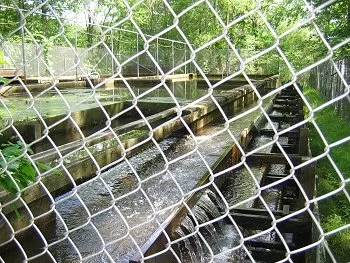In-lake restoration systems and other facilities
Addressing the problems of the water already in the lake presented the most serious scientific challenge, and perhaps the most spectacular success. By the late 1960's and early 1970's, Waramaug had moved into a serious state of decline—termed "eutrophication" by lake scientists. This was evidenced by massive algae blooms being fed by phosphorus released during the summer from the anoxic (oxygen-deficient) lake bottom.To deal with this problem the Task Force's limnologist, Robert W. Kortmann, Ph.D., designed a unique "hypolimentic withdrawal" system to help contain the lake bottom phosphorus in the deep layer of the lake. Two systems were installed in 1983—one at the tip of the Arrow Point peninsula, the other at the lake outlet in New Preston. In the following year there was a noticeable improvement in lake water clarity. The system at Arrow Point, named in memory of our long-time board member Bob Frost, had the added benefit of reducing the available phosphorus in the lake by "fixing" it to the lake's abundant natural iron.
In 1989, we installed new Kortmann-designed Layer Aeration systems (photos below) and suspended them in deep water along the Route 45 lake shoreline. These more energy efficient systems allowed us to replace the New Preston hypolimnetic withdrawal system and greatly expanded the volume of water being circulated and aerated in the lake.
In 2015, two new Layer Aeration systems were installed near Arrow Point to replace the 32-year-old land-based Hypolymnetic Withdrawal System at the Frost Site. Dr. Kortmann then conceived of a new function for this site—the potential cultivation of zooplankton.
Each of these systems also benefit the lake by creating large areas of cold, well-oxygenated water habitat needed by cold water fish and zooplankton, the native natural predator of algae.
We’ve also designed, funded and installed facilities outside of the lake but within the critical watershed area. They include waste catch-basins at a local farm and vineyard, designed to trap and filter harmful pollutants before they can flow into the lake. In addition, a biofilter was installed at an innovative buffer planting site on West Shore Road near New Preston.










